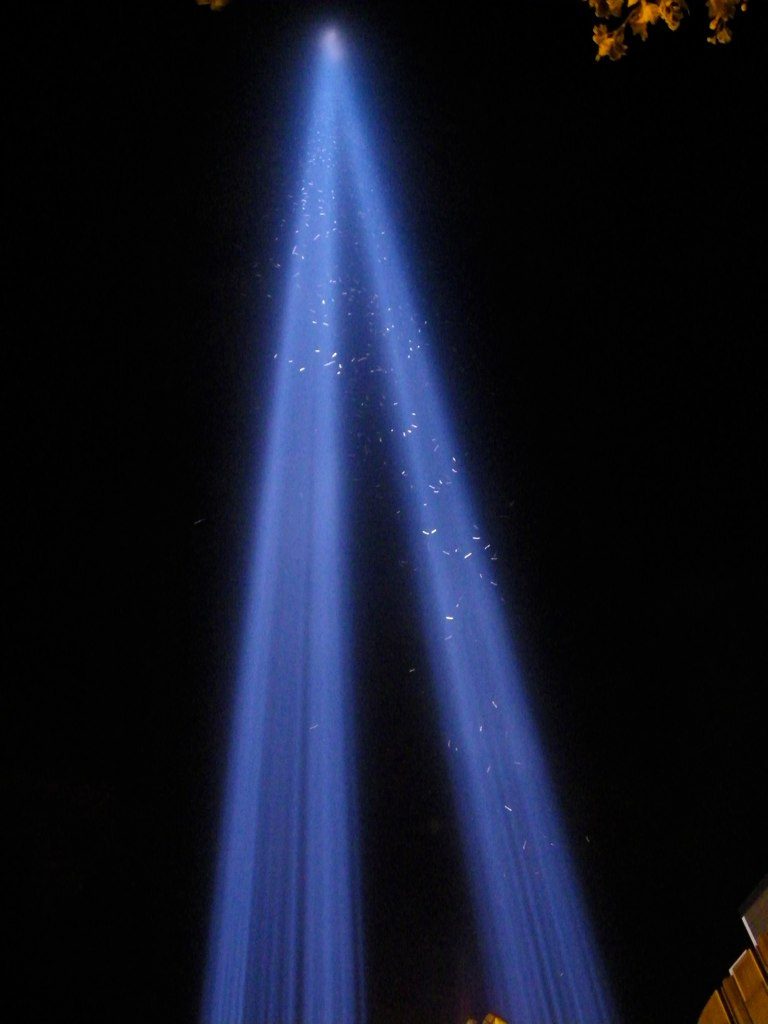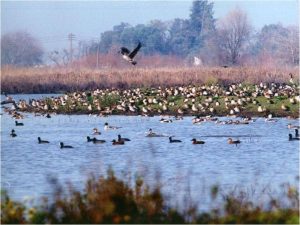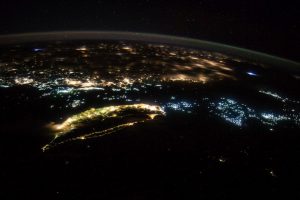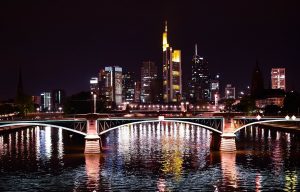Light pollution and birds – Part 1: Journey to Death
It’s autumn time. Millions of birds meet in the sky for their journey to the South. For many of them it’s their first journey to a place they have never seen before. For many it will be their last. Because this journey is full of danger. Mortal dangers.
The first problem is the simple fact that migrating birds have to travel thousands of kilometers. Take the willow warbler. Putting as little as nine gramm on the scale, it will fly from Central Europe to the tropical Africa. On this way, it will have to avoid the claws of birds of prey and nets and cooking-pots of mediterranean bird-catchers. Not commonly known is another danger: artificially light structures,
Many birds migrate at night. The air is calmer than, thus the birds need less strength on their flight. There are less predators out at night, too. How birds navigate on their journey hasn’t been explained completely yet, but they rely on three methods: Moon and stars, the magnetic field of Earth, and sight. Light plays an important factor with all of these. Not only fly birds towards celestial objects like the moon or use star constellations as landmarks, they also use the polarised light of the stars. More puzzling is the fact that the birds’ magnetic compass is actually linked to their visual sense. Red light has been shown to confuse magnetic oriention in birds in the lab, though it’s not clear what exactly is going on.
On their journey, birds regulary cross city skies. Here, they run into a couple of problems. The electrosmog and illumination of the cities interferes with their magnetic compass, so birds need to switch to visual flight. But the artificial illumination of cities is so much brighter than the natural light that birds get confused. They follow the brightest light – which should be the moon – and crash into an illuminated skyscraper. Their journey ends.
Artificial Light at night kills millions of birds
In 2013, the team of Travis Longcore estimated that in North America each year around 7 millionen birds are killed by collisions with illuminated radio towers. Just for comparison: wind mills kill between 140,000 and 328,000 in the same area. Add to this number the birds killed by illuminated buildings in cities and it gets quite scary. The Fatal Light Awareness Program (FLAP) Kanada wanted to lower these numbers and asked the operators of buildings to switch off the lights during migration time. Most buildings followed this simple and cheap suggestion to actively protect the environment, and indeed less birds were killed.

Nonetheless the danger of lights to birds are still unknown to most people. Instead, we use more light, because LED-technology makes illuminations affordable and there is a competition to have the brightest building in town. And there are events using immense amounts of light. Like the World Trade Center Memorial in Lights. Each year in September, for one week, 88 spot lights, each one with a power of 7,000 Watt, project two light beams into the sky above Manhattan. An awe-inspiring spectacle.
But there is an ecological toll to pay. During a seven year study, about 1,1 million birds have been attracted from as far as 1.5 kilometer. Manhatten is on one of the major migration routes, and in early September, traffic is heavy in the air above New York.
The impact of the lights became clear very soon. Thousands of glittering birds circled in the light, vocalising frantically, for hours. Many collided with each other or with buildings. It’s unknown how many died, but probably a few thousand. The organisors went into action. Each year volunteers from the Audubon Society check the light beams for birds. Are too many birds caught in the light, the beams are switched off until the birds have escaped. No more dead birds have been found.
However, you don’t need such a big light installlation to kill birds. On Oktober 15, 2019, 300 chimney swifts crashed into the lit windows of the NASCAR Hall of Fame in Charlotte, USA. More than a hundred died, another hundred had to be treated. The media started to guess the reasons, but for bird conservationists it’s obvious that the bright windows attracted the birds. This was no isolated incident. There have been several reports of high numbers of birds being killed on brightly illuminated buildings or monuments. In one case a strong beam from an airfield killed more than 50,000 birds in one night.
Even the birds that escape the light have to pay a price

Even if a bird escapes the lights, it’s not saved. These animals are weak and need extended stopovers in resting areas. Today, these areas are less often in ecologically suitable areas, but closer to the cities. The high number of birds draws heavily on the ressourcen and can become a problem for the residential animals and plants there. Also, elongated stops delay the journey of the migrating birds and they might arrive to late at their destination.
Ideally, we would switch off all fassade lights. Toronto has proven already that this is possible for at least the migration season. In France and Bavaria it is mandatory to switch of the illumination of public buildings and monuments. But the number of illuminated buildings increases. This is a danger for birds, but also worring regarding energy consumption.
Light pollution also affects seabirds
But not even the sky above our oceans is dark. Light pollution has been shown to be be the second largest threat for petrels and shearwaters, even more threatening than climate change and plastic waste. It’s especially young birds that are in danger. Their first flight starts at night, and they are supposed to head out to the open sea where they will stay for the rest of the year. Unfortunately, the lights of coastal towns and ports lures them back to the shore. Here they die from exhaustion, are killed by cars, or get eaten by cats and dogs.

Out on the open sea, birds collide with illuminated oil platforms or are drawn into the brigth beams of the fishery fleets. It has been reported that on boat capsised after about 6,000 crested auks decided to land on it.
It obvious that some structure have to be illuminated for safety reasons, including oil platforms, windmills, and radio towers. Some industrial sites are lit the entire night, even if no workers are around. They are mostly lit by energy-efficient sodium-lights. If you switch off these lights, they need about 15 minutes to cool down before you can switch them on again. 15 Minutes you don’t have if there in an emergency. So the light stays on.
The colour of light can make a difference
Kellie Pendoley, an Australian ecologist, advises companies in terms of environmentally-conscious illumination. She prefers LEDs, which can be switched off and on in short intervals. And she prefers orange LEDs.
Lab experiments have shown that birds react differently on different light colours. Red light interferes with the magnetic compass. Based on this, a team of researchers in cooperation with Philips tested the use of green light on oil platforms. Their results were promising: less birds were attracted by this light. Two different studies with higher sample sizes, however, could not confirm these results. Migratory birds as well as shearwaters were less attracted by red light.
Red light has even more advantages: it is less attractive for insects, bats, and sea turtles, does not influence the melatonin levels of animals including us humans, and is less glaring. But no matter what light you choose, we must realise that every light has a negative ecological impact. Before we illuminate a place, we should be sure that we need the light. A brightly illuminated skyline, as impressive as it might look, should not be worth killing thousands of birds.
Quellen:
Dick, M.H. and Donaldson, W. 1978. Fishing vessel endangered by Crested Auklet landings. Condor 80(2): 235-236.
Longcore, T. et al. 2013. Avian mortality at communication towers in the United States and Canada: Which species, how many, and where? Biological Conservation, 158(4): 410–419. doi: 10.1016/j.biocon.2012.09.019.
McLaren, J. D. et al. 2018. Artificial light at night confounds broad-scale habitat use by migrating birds. Ecology Letters 21(3): 356–364. doi: 10.1111/ele.12902
Poot, H. et al. 2009. Green Light for Nocturnally Migrating Birds. Ecology and Society 13(2): 47.
Rebke, M. et al. 2019. Attraction of nocturnally migrating birds to artificial light: The influence of colour, intensity and blinking mode under different cloud cover conditions. Biological Conservation 233(June 2018): 220–227. doi: 10.1016/j.biocon.2019.02.029.
Rodríguez, A., Dann, P. and Chiaradia, A. 2017. Reducing light-induced mortality of seabirds: High pressure sodium lights decrease the fatal attraction of shearwaters. Journal for Nature Conservation. 39: 68–72. doi: 10.1016/j.jnc.2017.07.001.
Rodríguez, A. et al. 2019. Future Directions in Conservation Research on Petrels and Shearwaters. Front Mar Sc 6: 94. doi: 10.3389/fmars.2019.00094.
Titelbild: von Imageduniya – Own work, CC BY-SA 4.0, Link

